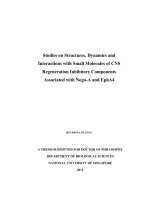Quantification of biomolecule dynamics and interactions in living zebrafish embryos by fluorescence correlation spectroscopy
Bạn đang xem bản rút gọn của tài liệu. Xem và tải ngay bản đầy đủ của tài liệu tại đây (5.98 MB, 158 trang )
QUANTIFICATIONOFBIOMOLECULEDYNAMICSAND
INTERACTIONSINLIVINGZEBRAFISHEMBRYOSBY
FLUORESCENCECORRELATIONSPECTROSCOPY
SHIXIANKE
(B.Sc.,USTC,P.R.CHINA)
ATHESISSUBMITTED
FORTHEDEGREEOFDOCTOROFPHILOSOPHY
DEARTMENTOFCHEMISTRY
NATIONALUNIVERSITYOFSINGAPORE
2009
I
This work is a result of collaboration between the Biophysical Fluorescence
LaboratoryatDepartmentofChemistry,NationalUniversityofSingapore(NUS)and
theFishDevelopmentBiologyLaboratoryatInstituteofMolecularandCellBiology
(IMCB),underthe supervisionofAssociateProfessorThorsten Wohland(NUS) and
AssociateProfessorVladimirKorzh(IMCB),betweenJuly2004andNovember2008.
Theresultshavebeenpartlypublishedin:
Shi, X., Teo, L. S., Pan, X., Chong, S. W., Kraut, R., Korzh, V., & Wohland, T., 2009,
Probingeventswithsinglemoleculesensitivityinzebrafishand Drosophilaembryos
byfluorescencecorrelationspectroscopy,Dev.Dyn.,238(12),3156‐67
Shi,X.,Foo,Y.H.,Sudhaharan,T.,Chong, S.W.,Korzh,V.,Ahmed,S.,&Wohland,T.,
2009, Determination of dissociation constants in living zebrafish embryos with
singlewavelengthfluorescencecross‐correlationspectroscopy,Biophys.J.,(97)678‐
686
Shi.X.,andWohland,T.,Fluorescencecorrelationspectroscopy,2010,inNanoscopy
and Multidimensional Fluorescence Microscopy, edited by Diaspro, A., Taylor and
Francis
Pan, X., Shi, X., Korzh, V., Yu, H., & Wohland, T., 2009, Line scan fluorescence
correlationspectroscopyfor3Dmicrofluidicflowvelocitymeasurements,J.Biome.
Opt.,(14)024049
Pan, X., Yu, H., Shi, X., Korzh, V., & Wohland, T., 2007, Characterization of flow
direction in microchannels and zebrafish blood vessels by scanning fluorescence
correlationspectroscopy”J.Biome.Opt.,(12)014034
II
Acknowledgements
As a foreign student, I can still vividly remember the feeling of loneliness and
helplessness when I first came to Singapore and NUS. Without the help of many
people, a life would be difficult for the past five years, let alone a doctoral thesis.
Takingthisopportunity,Iwouldliketoexpressmydeepestgratitudetothemall.
I am heartily thankful to my supervisor Associate Professor Thorsten Wohland for
introducingmethisexcitingresearchprojectandguidingmeallthewaywithgreat
patience. His passion for scientific research deeply inspired me and his German‐
style seriousness towards work gradually influenced me. This thesis would not be
possiblewithouthisenlighteningadvicesandhearteningencouragements.
I would like to thank my co‐supervisor Associate Professor Vladimir Korzh for
offeringme theopportunity tojoinhis family‐likeresearchgroup andshowing me
theexcitingworldofdevelopmentalbiology.Hiskindsupportwasalwaysavailable
through these years and his profound knowledge of zebrafish research provided
numerousnewideastothiscross‐disciplinaryproject.
I would like to show my gratitude to Associate Professor Sohail Ahmed and
Associate Professor Rachel Kraut for the great collaboration. Their warm help and
supportmadecrucialcontributiontothiswork.
I am grateful to all my colleagues from the Biophysical Fluorescence Laboratory in
NUS: Liu Ping for helping me with the biological sample handling and FCS
measurementsincellcultures;PanXiaotaoforhelpingme withtheFCSalignments
and the two photon excitation instrument setup; Guo Lin and Foo Yong Hwee for
helpfuldiscussionsandcollaboration;YuLanlan,HwangLingChin,Liu Jun,HarJarYi,
KannanBalakrishnan,MannaManojKumar,TeoLinShinandJagadishSankaranfor
theirfriendshipsandsupport.
I am also grateful to all my colleagues from the Fish Development Biology
Laboratory
in IMCB: in particular, Chong Shang‐Wei for guidance of basic biology
and zebrafish research; Cathleen Teh, Poon Kar Lai and William Go for technical
assistance,helpfuldiscussionandtheirfriendships.
Lastbutnotleast,Iwouldliketothankmyparentsfortheirunconditionalloveand
care. I would
like to thank my beautiful wife Zhang Guifeng for her continuous
support,loveandthehappiestmomentsshebringstomylife.
III
TableofContents
Acknowledgements II
TableofContents III
Summary VI
ListofTables VIII
ListofFigures IX
ListofSymbolsandacronyms XI
Chapter1Introduction∙∙∙∙∙∙∙∙∙∙∙∙∙∙∙∙∙∙∙∙∙∙∙∙∙∙∙∙∙∙∙∙∙∙∙∙∙∙∙∙∙∙∙∙∙∙∙∙∙∙∙∙∙∙∙∙∙∙∙∙∙∙∙∙∙∙∙∙∙∙∙∙∙∙∙∙∙∙∙∙∙∙∙∙∙∙∙∙∙∙∙∙∙∙∙∙1
Chapter2TheoryandMethods∙∙∙∙∙∙∙∙∙∙∙∙∙∙∙∙∙∙∙∙∙∙∙∙∙∙∙∙∙∙∙∙∙∙∙∙∙∙∙∙∙∙∙∙∙∙∙∙∙∙∙∙∙∙∙∙∙∙∙∙∙∙∙∙∙∙∙∙∙∙∙∙∙∙∙∙∙∙∙∙∙10
2.1FluorescenceCorrelationSpectroscopy∙∙∙∙∙∙∙∙∙∙∙∙∙∙∙∙∙∙∙∙∙∙∙∙∙∙∙∙∙∙∙∙∙∙∙∙∙∙∙∙∙∙∙∙∙∙∙∙∙∙∙∙∙∙∙∙∙∙10
2.1.1TheAutocorrelationAnalysis∙∙∙∙∙∙∙∙∙∙∙∙∙∙∙∙∙∙∙∙∙∙∙∙∙∙∙∙∙∙∙∙∙∙∙∙∙∙∙∙∙∙∙∙∙∙∙∙∙∙∙∙∙∙∙∙∙∙∙∙∙∙∙∙∙∙∙∙10
2.1.2TranslationalDiffusion∙∙∙∙∙∙∙∙∙∙∙∙∙∙∙∙∙∙∙∙∙∙∙∙∙∙∙∙∙∙∙∙∙∙∙∙∙∙∙∙∙∙∙∙∙∙∙∙∙∙∙∙∙∙∙∙∙∙∙∙∙∙∙∙∙∙∙∙∙∙∙∙∙∙∙∙∙∙14
2.1.3FCSinstrumentation∙∙∙∙∙∙∙∙∙∙∙∙∙∙∙∙∙∙∙∙∙∙∙∙∙∙∙∙∙∙∙∙∙∙∙∙∙∙∙∙∙∙∙∙∙∙∙∙∙∙∙∙∙∙∙∙∙∙∙∙∙∙∙∙∙∙∙∙∙∙∙∙∙∙∙∙∙∙∙∙∙∙21
2.1.4DataFitting∙∙∙∙∙∙∙∙∙∙∙∙∙∙∙∙∙∙∙∙∙∙∙∙∙∙∙∙∙∙∙∙∙∙∙∙∙∙∙∙∙∙∙∙∙∙∙∙∙∙∙∙∙∙∙∙∙∙∙∙∙∙∙∙∙∙∙∙∙∙∙∙∙∙∙∙∙∙∙∙∙∙∙∙∙∙∙∙∙∙∙∙∙∙∙∙25
2.2SingleWavelengthFluorescenceCross‐CorrelationSpectroscopy∙∙∙∙∙∙∙∙∙∙∙∙∙∙∙∙∙27
2.2.1Introduction∙∙∙∙∙∙∙∙∙∙∙∙∙∙∙∙∙∙∙∙∙∙∙∙∙∙∙∙∙∙∙∙∙∙∙∙∙∙∙∙∙∙∙∙∙∙∙∙∙∙∙∙∙∙∙∙∙∙∙∙∙∙∙∙∙∙∙∙∙∙∙∙∙∙∙∙∙∙∙∙∙∙∙∙∙∙∙∙∙∙∙∙∙∙27
2.2.2TheoryofSW‐FCCS∙∙∙∙∙∙∙∙∙∙∙∙∙∙∙∙∙∙∙∙∙∙∙∙∙∙∙∙∙∙∙∙∙∙∙∙∙∙∙∙∙∙∙∙∙∙∙∙∙∙∙∙∙∙∙∙∙∙∙∙∙∙∙∙∙∙∙∙∙∙∙∙∙∙∙∙∙∙∙∙∙∙∙∙29
2.2.3BindingQuantification∙∙∙∙∙∙∙∙∙∙∙∙∙∙∙∙∙∙∙∙∙∙∙∙∙∙∙∙∙∙∙∙∙∙∙∙∙∙∙∙∙∙∙∙∙∙∙∙∙∙∙∙∙∙∙∙∙∙∙∙∙∙∙∙∙∙∙∙∙∙∙∙∙∙∙∙∙∙33
2.2.4SW‐FCCSInstrumentation∙∙∙∙∙∙∙∙∙∙∙∙∙∙∙∙∙∙∙∙∙∙∙∙∙∙∙∙∙∙∙∙∙∙∙∙∙∙∙∙∙∙∙∙∙∙∙∙∙∙∙∙∙∙∙∙∙∙∙∙∙∙∙∙∙∙∙∙∙∙∙∙∙34
2.3PreparationofZebrafishEmbryosforImagingandSW‐FCCSMeasurements37
2.3.1ZebrafishEmbryoPreparation∙∙∙∙∙∙∙∙∙∙∙∙∙∙∙∙∙∙∙∙∙∙∙∙∙∙∙∙∙∙∙∙∙∙∙∙∙∙∙∙∙∙∙∙∙∙∙∙∙∙∙∙∙∙∙∙∙∙∙∙∙∙∙∙∙∙37
2.3.2ImagingandFCS/SW‐FCCSMeasurementsofZebrafishEmbryos∙∙∙∙∙∙∙∙∙∙∙40
2.4Preparationofbiologicalsamples∙∙∙∙∙∙∙∙∙∙∙∙∙∙∙∙∙∙∙∙∙∙∙∙∙∙∙∙∙∙∙∙∙∙∙∙∙∙∙∙∙∙∙∙∙∙∙∙∙∙∙∙∙∙∙∙∙∙∙∙∙∙∙∙∙∙∙∙42
Chapter3ZebrafishembryoasamodelforFCSmeasurements∙∙∙∙∙∙∙∙∙∙∙∙∙∙∙∙∙∙∙∙∙∙∙∙∙∙∙∙∙∙44
3.1Introduction∙∙∙∙∙∙∙∙∙∙∙∙∙∙∙∙∙∙∙∙∙∙∙∙∙∙∙∙∙∙∙∙∙∙∙∙∙∙∙∙∙∙∙∙∙∙∙∙∙∙∙∙∙∙∙∙∙∙∙∙∙∙∙∙∙∙∙∙∙∙∙∙∙∙∙∙∙∙∙∙∙∙∙∙∙∙∙∙∙∙∙∙∙∙∙∙∙∙∙∙∙44
3.2GeneExpressioninZebrafishEmbryos∙∙∙∙∙∙∙∙∙∙∙∙∙∙∙∙∙∙∙∙∙∙∙∙∙∙∙∙∙∙∙∙∙∙∙∙∙∙∙∙∙∙∙∙∙∙∙∙∙∙∙∙∙∙∙∙∙∙∙∙46
3.3AutofluorescenceStudy∙∙∙∙∙∙∙∙∙∙∙∙∙∙∙∙∙∙∙∙∙∙∙∙∙∙∙∙∙∙∙∙∙∙∙∙∙∙∙∙∙∙∙∙∙∙∙∙∙∙∙∙∙∙∙∙∙∙∙∙∙∙∙∙∙∙∙∙∙∙∙∙∙∙∙∙∙∙∙∙∙∙∙49
IV
3.3.1Introduction∙∙∙∙∙∙∙∙∙∙∙∙∙∙∙∙∙∙∙∙∙∙∙∙∙∙∙∙∙∙∙∙∙∙∙∙∙∙∙∙∙∙∙∙∙∙∙∙∙∙∙∙∙∙∙∙∙∙∙∙∙∙∙∙∙∙∙∙∙∙∙∙∙∙∙∙∙∙∙∙∙∙∙∙∙∙∙∙∙∙∙∙∙∙49
3.3.2Autofluorescencedistributioninembryobody∙∙∙∙∙∙∙∙∙∙∙∙∙∙∙∙∙∙∙∙∙∙∙∙∙∙∙∙∙∙∙∙∙∙∙∙∙∙∙∙50
3.3.3AutofluorescenceSpectrum∙∙∙∙∙∙∙∙∙∙∙∙∙∙∙∙∙∙∙∙∙∙∙∙∙∙∙∙∙∙∙∙∙∙∙∙∙∙∙∙∙∙∙∙∙∙∙∙∙∙∙∙∙∙∙∙∙∙∙∙∙∙∙∙∙∙∙∙∙53
3.3.4AutoflurescenceIntensity∙∙∙∙∙∙∙∙∙∙∙∙∙∙∙∙∙∙∙∙∙∙∙∙∙∙∙∙∙∙∙∙∙∙∙∙∙∙∙∙∙∙∙∙∙∙∙∙∙∙∙∙∙∙∙∙∙∙∙∙∙∙∙∙∙∙∙∙∙∙∙∙∙54
3.4PenetrationDepthStudy∙∙∙∙∙∙∙∙∙∙∙∙∙∙∙∙∙∙∙∙∙∙∙∙∙∙∙∙∙∙∙∙∙∙∙∙∙∙∙∙∙∙∙∙∙∙∙∙∙∙∙∙∙∙∙∙∙∙∙∙∙∙∙∙∙∙∙∙∙∙∙∙∙∙∙∙∙∙∙∙∙57
3.4.1Introduction∙∙∙∙∙∙∙∙∙∙∙∙∙∙∙∙∙∙∙∙∙∙∙∙∙∙∙∙∙∙∙∙∙∙∙∙∙∙∙∙∙∙∙∙∙∙∙∙∙∙∙∙∙∙∙∙∙∙∙∙∙∙∙∙∙∙∙∙∙∙∙∙∙∙∙∙∙∙∙∙∙∙∙∙∙∙∙∙∙∙∙∙∙∙57
3.4.2Penetrationdepthofconfocalmicroscopy∙∙∙∙∙∙∙∙∙∙∙∙∙∙∙∙∙∙∙∙∙∙∙∙∙∙∙∙∙∙∙∙∙∙∙∙∙∙∙∙∙∙∙∙∙∙58
3.4.3PenetrationdepthofFCSusingOPE∙∙∙∙∙∙∙∙∙∙∙∙∙∙∙∙∙∙∙∙∙∙∙∙∙∙∙∙∙∙∙∙∙∙∙∙∙∙∙∙∙∙∙∙∙∙∙∙∙∙∙∙∙∙∙∙∙60
3.4.4PenetrationdepthofFCSusingTPE∙∙∙∙∙∙∙∙∙∙∙∙∙∙∙∙∙∙∙∙∙∙∙∙∙∙∙∙∙∙∙∙∙∙∙∙∙∙∙∙∙∙∙∙∙∙∙∙∙∙∙∙∙∙∙∙∙∙62
Chapter4ProbeSingleMoleculeEventsinLivingZebrafishEmbryoswithFCS∙∙∙∙∙∙∙69
4.1Introduction∙∙∙∙∙∙∙∙∙∙∙∙∙∙∙∙∙∙∙∙∙∙∙∙∙∙∙∙∙∙∙∙∙∙∙∙∙∙∙∙∙∙∙∙∙∙∙∙∙∙∙∙∙∙∙∙∙∙∙∙∙∙∙∙∙∙∙∙∙∙∙∙∙∙∙∙∙∙∙∙∙∙∙∙∙∙∙∙∙∙∙∙∙∙∙∙∙∙∙∙∙69
4.2BloodFlowMeasurementsinLivingZebrafishEmbryo∙∙∙∙∙∙∙∙∙∙∙∙∙∙∙∙∙∙∙∙∙∙∙∙∙∙∙∙∙∙∙∙∙∙∙71
4.2.1Introduction∙∙∙∙∙∙∙∙∙∙∙∙∙∙∙∙∙∙∙∙∙∙∙∙∙∙∙∙∙∙∙∙∙∙∙∙∙∙∙∙∙∙∙∙∙∙∙∙∙∙∙∙∙∙∙∙∙∙∙∙∙∙∙∙∙∙∙∙∙∙∙∙∙∙∙∙∙∙∙∙∙∙∙∙∙∙∙∙∙∙∙∙∙∙71
4.2.2FCSTheoryofFlowMeasurement∙∙∙∙∙∙∙∙∙∙∙∙∙∙∙∙∙∙∙∙∙∙∙∙∙∙∙∙∙∙∙∙∙∙∙∙∙∙∙∙∙∙∙∙∙∙∙∙∙∙∙∙∙∙∙∙∙∙∙∙72
4.2.3FlowVelocityMeasurementbyFCS∙∙∙∙∙∙∙∙∙∙∙∙∙∙∙∙∙∙∙∙∙∙∙∙∙∙∙∙∙∙∙∙∙∙∙∙∙∙∙∙∙∙∙∙∙∙∙∙∙∙∙∙∙∙∙∙∙∙74
4.3ProteinTranslationalDiffusionMeasurementsinLivingZebrafishEmbryo∙∙∙78
4.3.1Introduction∙∙∙∙∙∙∙∙∙∙∙∙∙∙∙∙∙∙∙∙∙∙∙∙∙∙∙∙∙∙∙∙∙∙∙∙∙∙∙∙∙∙∙∙∙∙∙∙∙∙∙∙∙∙∙∙∙∙∙∙∙∙∙∙∙∙∙∙∙∙∙∙∙∙∙∙∙∙∙∙∙∙∙∙∙∙∙∙∙∙∙∙∙∙78
4.3.2ProteinTranslationalDiffusionMeasurementsinCytoplasmand
Nucleoplasm∙∙∙∙∙∙∙∙∙∙∙∙∙∙∙∙∙∙∙∙∙∙∙∙∙∙∙∙∙∙∙∙∙∙∙∙∙∙∙∙∙∙∙∙∙∙∙∙∙∙∙∙∙∙∙∙∙∙∙∙∙∙∙∙∙∙∙∙∙∙∙∙∙∙∙∙∙∙∙∙∙∙∙∙∙∙∙∙∙∙∙∙∙∙∙∙∙∙∙∙∙∙∙79
4.3.3ProteinTranslationalDiffusionMeasurementsinMotorNeuronCellsand
MuscleFiberCells∙∙∙∙∙∙∙∙∙∙∙∙∙∙∙∙∙∙∙∙∙∙∙∙∙∙∙∙∙∙∙∙∙∙∙∙∙∙∙∙∙∙∙∙∙∙∙∙∙∙∙∙∙∙∙∙∙∙∙∙∙∙∙∙∙∙∙∙∙∙∙∙∙∙∙∙∙∙∙∙∙∙∙∙∙∙∙∙∙∙∙∙∙∙82
4.3.4ProteinTranslationalDiffusionMeasurementsofCxcr4b‐EGFPon
Membrane∙∙∙∙∙∙∙∙∙∙∙∙∙∙∙∙∙∙∙∙∙∙∙∙∙∙∙∙∙∙∙∙∙∙∙∙∙∙∙∙∙∙∙∙∙∙∙∙∙∙∙∙∙∙∙∙∙∙∙∙∙∙∙∙∙∙∙∙∙∙∙∙∙∙∙∙∙∙∙∙∙∙∙∙∙∙∙∙∙∙∙∙∙∙∙∙∙∙∙∙∙∙∙∙∙∙86
4.3.5DataAnalysisUsingAnomalousSubdiffusionModel∙∙∙∙∙∙∙∙∙∙∙∙∙∙∙∙∙∙∙∙∙∙∙∙∙∙∙∙∙∙∙89
Chapter5DeterminationofDissociationConstantsinLivingZebrafishEmbryoswith
SW‐FCCS∙∙∙∙∙∙∙∙∙∙∙∙∙∙∙∙∙∙∙∙∙∙∙∙∙∙∙∙∙∙∙∙∙∙∙∙∙∙∙∙∙∙∙∙∙∙∙∙∙∙∙∙∙∙∙∙∙∙∙∙∙∙∙∙∙∙∙∙∙∙∙∙∙∙∙∙∙∙∙∙∙∙∙∙∙∙∙∙∙∙∙∙∙∙∙∙∙∙∙∙∙∙∙∙∙∙∙∙∙∙∙∙∙∙∙∙∙92
5.1Introduction∙∙∙∙∙∙∙∙∙∙∙∙∙∙∙∙∙∙∙∙∙∙∙∙∙∙∙∙∙∙∙∙∙∙∙∙∙∙∙∙∙∙∙∙∙∙∙∙∙∙∙∙∙∙∙∙∙∙∙∙∙∙∙∙∙∙∙∙∙∙∙∙∙∙∙∙∙∙∙∙∙∙∙∙∙∙∙∙∙∙∙∙∙∙∙∙∙∙∙∙∙92
5.2SystemCalibration∙∙∙∙∙∙∙∙∙∙∙∙∙∙∙∙∙∙∙∙∙∙∙∙∙∙∙∙∙∙∙∙∙∙∙∙∙∙∙∙∙∙∙∙∙∙∙∙∙∙∙∙∙∙∙∙∙∙∙∙∙∙∙∙∙∙∙∙∙∙∙∙∙∙∙∙∙∙∙∙∙∙∙∙∙∙∙∙∙∙∙94
5.2.1Determinationofcps,background,andcorrectionfactors∙∙∙∙∙∙∙∙∙∙∙∙∙∙∙∙∙∙∙∙∙∙94
5.2.2DeterminationoftheEffectiveVolume∙∙∙∙∙∙∙∙∙∙∙∙∙∙∙∙∙∙∙∙∙∙∙∙∙∙∙∙∙∙∙∙∙∙∙∙∙∙∙∙∙∙∙∙∙∙∙∙∙∙∙∙96
V
5.2.3InstrumentCalibration∙∙∙∙∙∙∙∙∙∙∙∙∙∙∙∙∙∙∙∙∙∙∙∙∙∙∙∙∙∙∙∙∙∙∙∙∙∙∙∙∙∙∙∙∙∙∙∙∙∙∙∙∙∙∙∙∙∙∙∙∙∙∙∙∙∙∙∙∙∙∙∙∙∙∙∙∙∙97
5.3ControlMeasurements∙∙∙∙∙∙∙∙∙∙∙∙∙∙∙∙∙∙∙∙∙∙∙∙∙∙∙∙∙∙∙∙∙∙∙∙∙∙∙∙∙∙∙∙∙∙∙∙∙∙∙∙∙∙∙∙∙∙∙∙∙∙∙∙∙∙∙∙∙∙∙∙∙∙∙∙∙∙∙∙∙∙∙∙99
5.3.1MixtureofmRFPandEGFPasNegativeControl∙∙∙∙∙∙∙∙∙∙∙∙∙∙∙∙∙∙∙∙∙∙∙∙∙∙∙∙∙∙∙∙∙∙∙∙∙∙99
5.3.2mRFP‐EGFPTandemConstructasPositiveControl∙∙∙∙∙∙∙∙∙∙∙∙∙∙∙∙∙∙∙∙∙∙∙∙∙∙∙∙∙∙∙∙101
5.4InteractionofCdc42andIQGAP1∙∙∙∙∙∙∙∙∙∙∙∙∙∙∙∙∙∙∙∙∙∙∙∙∙∙∙∙∙∙∙∙∙∙∙∙∙∙∙∙∙∙∙∙∙∙∙∙∙∙∙∙∙∙∙∙∙∙∙∙∙∙∙∙∙∙105
5.4.1Introduction∙∙∙∙∙∙∙∙∙∙∙∙∙∙∙∙∙∙∙∙∙∙∙∙∙∙∙∙∙∙∙∙∙∙∙∙∙∙∙∙∙∙∙∙∙∙∙∙∙∙∙∙∙∙∙∙∙∙∙∙∙∙∙∙∙∙∙∙∙∙∙∙∙∙∙∙∙∙∙∙∙∙∙∙∙∙∙∙∙∙∙∙105
5.4.2InteractionofCdc42
G12V
andIQGAP1∙∙∙∙∙∙∙∙∙∙∙∙∙∙∙∙∙∙∙∙∙∙∙∙∙∙∙∙∙∙∙∙∙∙∙∙∙∙∙∙∙∙∙∙∙∙∙∙∙∙∙∙∙108
5.4.3InteractionofCdc42
T17N
andIQGAP1∙∙∙∙∙∙∙∙∙∙∙∙∙∙∙∙∙∙∙∙∙∙∙∙∙∙∙∙∙∙∙∙∙∙∙∙∙∙∙∙∙∙∙∙∙∙∙∙∙∙∙∙∙111
5.4.4ComparisonofResultsfromZebrafishEmbryoandCHOcells∙∙∙∙∙∙∙∙∙∙∙∙∙∙∙115
5.4.5Summary∙∙∙∙∙∙∙∙∙∙∙∙∙∙∙∙∙∙∙∙∙∙∙∙∙∙∙∙∙∙∙∙∙∙∙∙∙∙∙∙∙∙∙∙∙∙∙∙∙∙∙∙∙∙∙∙∙∙∙∙∙∙∙∙∙∙∙∙∙∙∙∙∙∙∙∙∙∙∙∙∙∙∙∙∙∙∙∙∙∙∙∙∙∙∙∙∙117
Chapter6ConclusionandOutlook∙∙∙∙∙∙∙∙∙∙∙∙∙∙∙∙∙∙∙∙∙∙∙∙∙∙∙∙∙∙∙∙∙∙∙∙∙∙∙∙∙∙∙∙∙∙∙∙∙∙∙∙∙∙∙∙∙∙∙∙∙∙∙∙∙∙∙∙∙∙∙∙∙∙120
6.1Conclusion∙∙∙∙∙∙∙∙∙∙∙∙∙∙∙∙∙∙∙∙∙∙∙∙∙∙∙∙∙∙∙∙∙∙∙∙∙∙∙∙∙∙∙∙∙∙∙∙∙∙∙∙∙∙∙∙∙∙∙∙∙∙∙∙∙∙∙∙∙∙∙∙∙∙∙∙∙∙∙∙∙∙∙∙∙∙∙∙∙∙∙∙∙∙∙∙∙∙∙∙∙∙120
6.2Outlook∙∙∙∙∙∙∙∙∙∙∙∙∙∙∙∙∙∙∙∙∙∙∙∙∙∙∙∙∙∙∙∙∙∙∙∙∙∙∙∙∙∙∙∙∙∙∙∙∙∙∙∙∙∙∙∙∙∙∙∙∙∙∙∙∙∙∙∙∙∙∙∙∙∙∙∙∙∙∙∙∙∙∙∙∙∙∙∙∙∙∙∙∙∙∙∙∙∙∙∙∙∙∙∙∙∙∙125
References∙∙∙∙∙∙∙∙∙∙∙∙∙∙∙∙∙∙∙∙∙∙∙∙∙∙∙∙∙∙∙∙∙∙∙∙∙∙∙∙∙∙∙∙∙∙∙∙∙∙∙∙∙∙∙∙∙∙∙∙∙∙∙∙∙∙∙∙∙∙∙∙∙∙∙∙∙∙∙∙∙∙∙∙∙∙∙∙∙∙∙∙∙∙∙∙∙∙∙∙∙∙∙∙∙∙∙∙∙∙∙∙131
VI
Summary
Fluorescence correlation spectroscopy (FCS) and fluorescence cross‐correlation
spectroscopy (FCCS) are widely used biophysical techniques to determine
biomolecule concentrations, photophysical dynamics of fluorophores, diffusion
coefficientsofDNAsandproteins,anddissociationconstantsofinteractingparticles.
In this work, we extended the application of FCS and single wavelength
fluorescencecross‐correlationspectroscopy(SW‐FCCS),avariantofFCCSdeveloped
in our lab, to a multicellular living organism. We chose zebrafish embryo for this
purposeasitstransparenttissueaidedtheinvestigationsofcellsdeepbeneathskin.
Wefirstexaminedhowandtowhatextentzebrafishembryoscanbestudiedusing
FCS. Then the applicability of FCS to study molecular processes in embryo was
demonstrated by the determination of blood flow velocities with high spatial
resolution and the determination of diffusion coefficients of cytoplasmic and
membrane‐boundenhanced green fluorescence protein (EGFP) labeled proteins in
differentsubcellularcompartmentsaswellasindifferentcelltypes.Lastly,weshow
that protein‐protein interactions can be directly quantified in muscle fiber cells in
living zebrafish embryo with SW‐FCCS. This thesis is organized in the following
chapters:
1. Chapter 1 introduces the motivation to study protein dynamics and
interactionsinlivingorg anisms.Itprovidesa
literaturereviewonthehistory
and development of FCS/SW‐FCCS, as well as the application of FCS/SW‐
FCCSinstudyingbiomoleculedynamicsandinteractions.
2. Chapter 2 describes the theories and experimental setups of FCS and SW‐
FCCS.Thepreparationofbiologicalsamplesandthepreparationofzebrafish
embryoforimaging
andFCSmeasurementarealsoillustratedanddiscussed
inthischapter.
3. Chapter3examineshowandtowhatextentzebrafishembryocanbeused
as a model for the study of molecular processes. Firstly, the approachesto
express foreign genes in zebrafish embryos are discussed and compared
with that in cell cultures. Secondly, the autofluorescence in living zebrafish
embryos, in particular the autofluorescence distribution and emission
spectra, is examined in order to minimize background interference. Lastly,
the working distance of FCS measurements in zebrafish tissues is studied
withbothonephotonexcitationandtwophotonexcitation.
VII
4. Chapter 4 presents the studies of molecular processes in living zebrafish
embryos with FCS. We first show that systolic and diastolic blood flow
velocitiescanbenoninvasively determinedwithhighspatialresolutioneven
intheabsenceofredbloodcells.Wethenshowthatdiffusioncoefficientsof
cytoplasmic and membrane‐bound proteins can be accurately determined.
We measure the diffusion coefficients of EGFP in cytoplasm and
nucleoplasm,aswellasinmotorneuroncellsandmusclefibercells.Wealso
determine the diffusion coefficients of Cxcr4b‐EGFP, an EGFP labeled G
protein coupled receptor (GPCR), on the plasma membrane of the muscle
fibercells.WefinallyanalyzetheFCSdatawiththeanomaloussubdiffusion
modelandstudythemolecularcrowdednessofcellsinlivingembryos.
5. Chapter5describesthedirectquantificationofprotein‐proteininteractions
in living zebrafish embryos with SW‐FCCS. The SW‐FCCS instrument is
calibrated using Rhodamine 6G and the effective volume is calculated
accordingly. Positive (mRFP‐EGFP tandem construct) and negative
(individuallyexpressedmRFPandEGFP)controlsaremeasuredfirsttoprobe
theupperandlowerlimitsofSW‐FCCSmeasurementsinembryos.Thenthe
interactions of Cdc42, a small Rho‐GTPase, and IQGAP1, an actin‐binding
scaffolding protein, are studied and the dissociation constants are
determined.Finally,theresultsobtainedinzebrafishembryosarecompared
tothatinChinesehamsterovarycellcultures.
6. Chapter 6 concludes the finding in this work and envisions the future
developmentofFCS/SW‐FCCSinembryos.
VIII
ListofTables
Table4.1:Bloodflowvelocitiesofdorsalaortaandcardinalvein.∙∙∙∙∙∙∙∙∙∙∙∙∙∙∙∙∙∙∙∙∙∙∙∙∙∙∙76
Table4.2:Translationaldiffusionmeasurementsinzebrafishembryos∙∙∙∙∙∙∙∙∙∙∙∙∙∙∙∙∙∙∙91
Table5.1:Molecularbrightnessobtainedfromcalibration.∙∙∙∙∙∙∙∙∙∙∙∙∙∙∙∙∙∙∙∙∙∙∙∙∙∙∙∙∙∙∙∙∙∙∙∙∙96
Table5.2:DataobtainedfrommusclefibercellsinembryoandCHOcell∙∙∙∙∙∙∙∙∙∙∙∙∙118
Table6.1:Fluorescentpropertiesofsomefluorophores∙∙∙∙∙∙∙∙∙∙∙∙∙∙∙∙∙∙∙∙∙∙∙∙∙∙∙∙∙∙∙∙∙∙∙∙∙∙∙∙127
IX
ListofFigures
Fig.2.1:Characteristicsoffluorescencecorrelationfunctions∙∙∙∙∙∙∙∙∙∙∙∙∙∙∙∙∙∙∙∙∙∙∙∙∙∙∙∙∙∙∙∙∙20
Fig.2.2:AtypicalopticalsetupofconfocalFCS∙∙∙∙∙∙∙∙∙∙∙∙∙∙∙∙∙∙∙∙∙∙∙∙∙∙∙∙∙∙∙∙∙∙∙∙∙∙∙∙∙∙∙∙∙∙∙∙∙∙∙∙∙∙∙∙∙24
Fig.2.3:ExcitationandemissionspectraofEGFPandmRFP∙∙∙∙∙∙∙∙∙∙∙∙∙∙∙∙∙∙∙∙∙∙∙∙∙∙∙∙∙∙∙∙∙∙∙∙29
Fig.2.4:TheoryofFCCS∙∙∙∙∙∙∙∙∙∙∙∙∙∙∙∙∙∙∙∙∙∙∙∙∙∙∙∙∙∙∙∙∙∙∙∙∙∙∙∙∙∙∙∙∙∙∙∙∙∙∙∙∙∙∙∙∙∙∙∙∙∙∙∙∙∙∙∙∙∙∙∙∙∙∙∙∙∙∙∙∙∙∙∙∙∙∙∙∙∙∙∙∙∙31
Fig.2.5:AtypicalopticalsetupofSW‐FCCS∙∙∙∙∙∙∙∙∙∙∙∙∙∙∙∙∙∙∙∙∙∙∙∙∙∙∙∙∙∙∙∙∙∙∙∙∙∙∙∙∙∙∙∙∙∙∙∙∙∙∙∙∙∙∙∙∙∙∙∙∙∙∙36
Fig.2.6:Zebrafishembryopreparation∙∙∙∙∙∙∙∙∙∙∙∙∙∙∙∙∙∙∙∙∙∙∙∙∙∙∙∙∙∙∙∙∙∙∙∙∙∙∙∙∙∙∙∙∙∙∙∙∙∙∙∙∙∙∙∙∙∙∙∙∙∙∙∙∙∙∙∙∙39
Fig.2.7:Identificationofsinglecellandsubcellularcompartmentinzebrafish
embryo∙∙∙∙∙∙∙∙∙∙∙∙∙∙∙∙∙∙∙∙∙∙∙∙∙∙∙∙∙∙∙∙∙∙∙∙∙∙∙∙∙∙∙∙∙∙∙∙∙∙∙∙∙∙∙∙∙∙∙∙∙∙∙∙∙∙∙∙∙∙∙∙∙∙∙∙∙∙∙∙∙∙∙∙∙∙∙∙∙∙∙∙∙∙∙∙∙∙∙∙∙∙∙∙∙∙∙∙∙∙∙∙∙∙∙∙∙∙∙41
Fig.3.1:Autofluorescencedistributioninzebrafishembryobody∙∙∙∙∙∙∙∙∙∙∙∙∙∙∙∙∙∙∙∙∙∙∙∙∙∙∙52
Fig.3.2:Autofluorescencespectrum∙∙∙∙∙∙∙∙∙∙∙∙∙∙∙∙∙∙∙∙∙∙∙∙∙∙∙∙∙∙∙∙∙∙∙∙∙∙∙∙∙∙∙∙∙∙∙∙∙∙∙∙∙∙∙∙∙∙∙∙∙∙∙∙∙∙∙∙∙∙∙∙∙54
Fig.3.3:Fluorescenceintensitychangesagainstdepthinconfocalmicroscopy∙∙∙∙∙∙59
Fig.3.4:FCSpenetrationdepthstudyusingonephotonexcitation∙∙∙∙∙∙∙∙∙∙∙∙∙∙∙∙∙∙∙∙∙∙∙∙∙62
Fig.3.5:CalibrationofFCSusingtwophotonexcitation∙∙∙∙∙∙∙∙∙∙∙∙∙∙∙∙∙∙∙∙∙∙∙∙∙∙∙∙∙∙∙∙∙∙∙∙∙∙∙∙∙∙∙65
Fig.3.6:FCSpenetrationdepthstudyusingtwophotonexcitation∙∙∙∙∙∙∙∙∙∙∙∙∙∙∙∙∙∙∙∙∙∙∙∙∙68
Fig.4.1:FCSbloodflowmeasurementinlivingzebrafishembryos∙∙∙∙∙∙∙∙∙∙∙∙∙∙∙∙∙∙∙∙∙∙∙∙∙∙75
Fig.4.2:AtypicalFCSmeasurementofbloodflowintheheartofzebrafishembryo
∙∙∙∙∙∙∙∙∙∙∙∙∙∙∙∙∙∙∙∙∙∙∙∙∙∙∙∙∙∙∙∙∙∙∙∙∙∙∙∙∙∙∙∙∙∙∙∙∙∙∙∙∙∙∙∙∙∙∙∙∙∙∙∙∙∙∙∙∙∙∙∙∙∙∙∙∙∙∙∙∙∙∙∙∙∙∙∙∙∙∙∙∙∙∙∙∙∙∙∙∙∙∙∙∙∙∙∙∙∙∙∙∙∙∙∙∙∙∙∙∙∙∙∙∙∙∙∙∙∙∙∙77
Fig.4.3:Diffusiontimemeasurementswithinonecell∙∙∙∙∙∙∙∙∙∙∙∙∙∙∙∙∙∙∙∙∙∙∙∙∙∙∙∙∙∙∙∙∙∙∙∙∙∙∙∙∙∙∙∙∙82
Fig.4.4:Diffusiontimemeasurementsindifferentcelltypes∙∙∙∙∙∙∙∙∙∙∙∙∙∙∙∙∙∙∙∙∙∙∙∙∙∙∙∙∙∙∙∙∙∙∙85
Fig.4.5:DiffusiontimemeasurementsofCxcr4b‐EGFP∙∙∙∙∙∙∙∙∙∙∙∙∙∙∙∙∙∙∙∙∙∙∙∙∙∙∙∙∙∙∙∙∙∙∙∙∙∙∙∙∙∙∙∙88
Fig.5.1:SystemcalibrationusingRhodamine6G∙∙∙∙∙∙∙∙∙∙∙∙∙∙∙∙∙∙∙∙∙∙∙∙∙∙∙∙∙∙∙∙∙∙∙∙∙∙∙∙∙∙∙∙∙∙∙∙∙∙∙∙∙∙98
Fig.5.2:SW‐FCCScontrolmeasurementsinlivingzebrafishembryos∙∙∙∙∙∙∙∙∙∙∙∙∙∙∙∙∙∙∙∙103
X
Fig.5.3:Scatteringplotof
g
r
CC
vs
g
r
C
forbothpositiveandnegativecontrols∙104
Fig.5.4:Fiveprotein‐interactingdomainofIQGAP1∙∙∙∙∙∙∙∙∙∙∙∙∙∙∙∙∙∙∙∙∙∙∙∙∙∙∙∙∙∙∙∙∙∙∙∙∙∙∙∙∙∙∙∙∙∙∙106
Fig.5.5:InteractionofIQGAP1withCdc42andF‐actin∙∙∙∙∙∙∙∙∙∙∙∙∙∙∙∙∙∙∙∙∙∙∙∙∙∙∙∙∙∙∙∙∙∙∙∙∙∙∙∙∙∙108
Fig.5.6:SW‐FCCSmeasurementsofCdc42andIQGAP1∙∙∙∙∙∙∙∙∙∙∙∙∙∙∙∙∙∙∙∙∙∙∙∙∙∙∙∙∙∙∙∙∙∙∙∙∙∙∙∙∙111
Fig.5.7:DeterminationofK
D
fortheinteractingproteinpairofCdc42andIQGAP1
∙∙∙∙∙∙∙∙∙∙∙∙∙∙∙∙∙∙∙∙∙∙∙∙∙∙∙∙∙∙∙∙∙∙∙∙∙∙∙∙∙∙∙∙∙∙∙∙∙∙∙∙∙∙∙∙∙∙∙∙∙∙∙∙∙∙∙∙∙∙∙∙∙∙∙∙∙∙∙∙∙∙∙∙∙∙∙∙∙∙∙∙∙∙∙∙∙∙∙∙∙∙∙∙∙∙∙∙∙∙∙∙∙∙∙∙∙∙∙∙∙∙∙∙∙∙∙∙∙∙114
Fig.5.8:SW‐FCCSresultsobtainedinCHOcellculture∙∙∙∙∙∙∙∙∙∙∙∙∙∙∙∙∙∙∙∙∙∙∙∙∙∙∙∙∙∙∙∙∙∙∙∙∙∙∙∙∙∙∙119
Fig.6.1:Excitationandemissionspectraoftwofluorophorepairs∙∙∙∙∙∙∙∙∙∙∙∙∙∙∙∙∙∙∙∙∙∙∙∙128
XI
ListofSymbolsandAcronyms
anomalityfactor
mediumviscosity
correlationtime
d
diffusiontime
f
flowtimeforamoleculethroughtheobservationvolume
trip
tripletstaterelaxationtime
0
theradialdistancewheretheexcitationintensityreaches1/e
2
ofits
valueatthecenteroftheobservationvolume
2
Chisquare,usedtodescribegoodness‐of‐fit
ACF autocorrelationfunction
APD avalanchephotodiode
C Concentration
CCD charge‐coupleddevice
CCF cross‐correlationfunction
Cdc42 celldivisioncycle42
CHD Calponinhomologydomain
CHO Chinesehamsterovary
CLSM confocallaserscanningmicroscopy
CMV Cytomegalovirus
cps countratepermoleculepersecond
Cxcr4a/b chemokine(C‐X‐Cmotif)receptor4a/b
D diffusioncoefficient
DNA deoxyribonucleicacid
dpf dayspostfertilization
EGFP enhancedgreenfluorescenceprotein
EGFR epidermalgrowthfactorreceptor
XII
EMCCD electronmultiplyingcharge‐coupleddevice
EtBr ethidiumbromide
F(t) fluorescenceintensityattimet
FCM fluorescencecorrelationmicroscopy
FCS fluorescencecorrelationspectroscopy
FCCS fluorescencecross‐correlationspectroscopy
FLIM fluorescencelifetimeimagingmicroscopy
Flu Fluorescein
FP fluorescenceprotein
FRAP fluorescencerecoveryafterphotobleaching
FRET fluorescenceresonanceenergytransfer
F
trip
thefractionoftheparticlesthathaveenteredthetripletstate
x
g ,
y
g
,
z
g
basictermofcorrelationfunctionineachdimension
(0)G
correlationfunctionamplitude
()G
correlationfunction
G
theconvergencevalueof
()G
forinfinitetime
GDP guanosinediphosphate
GEF guaninenucleotideexchangefactor
GPCR G‐proteincoupledreceptor
GRD GAP‐relateddomain
GTP guanosinetriphosphate
IQGAP1 IQmotifcontainingGTPaseactivatingprotein1
K Boltzmann’sconstant
K
geometric ratio of axial to radial distance of the observatoion
volume,where
00
/Kz
K
D
dissociationconstant
hpf hourspostfertilization
M molecularmass
MO morpholinooligos
mRFP monomericredfluorescenceprotein
N numberofmolecules
XIII
N
A
Avogadro’snumber
NA numericalaperture
NIR nearinfrared
N‐WASP neural‐Wiskott‐Aldrichsyndromeprotein
OPE one‐photonexcitation
PBS phosphatebuffersolution
PCH photoncountinghistogram
PCR polymerasechainreaction
PIV particleimagingvelocity
PMT photomultipliertubes
PSF pointspreadfunction
PTU 0.003%1‐phenyl‐2‐thioureain10%Hank’ssaline
QD quantumdots
R6G rhodamine6G
SD standarddeviation
SW‐FCCS singlewavelengthfluorescencecross‐correlationspectroscopy
SPT singleparticletracking
T absolutetemperature
TIR totalinternalreflection
TMR tetramethylrhodamine
TPE two‐photonexcitation
UV Ultraviolet
V
eff
effectiveobservationvolume
z
0
theaxialdistancewheretheexcitationintensityreaches1/e
2
ofits
valueatthecenteroftheobservationvolume
Chapter1
Introduction
The end of the 20
th
and the beginning of the 21
st
century witnessed exciting
developmentsinthelifesciencesandtheemergenceofnovelquestionswithinthe
field.Inparticular,theadvancesinmolecularandcellbiologybroughttheneedto
understandcellbehaviorbasedonveryfundamentalmolecularprocesses.However,
conventional ensemble or bulk measurements cannot address this issue as single
moleculeparametersand their distributionaremasked by theensemble averages
andstandard deviations.Under ensemblemeasurement,questionswhether there
isoneormultiplemolecularspecies,e.g.proteinsofmultipleconformations,cannot
be answered. Thus new tools and strategies that can detect single molecules and
distinguish a single molecule among heterogeneous populations are needed. The
firstsingle moleculedetectionwasachievedin1976usingfluorescencemicroscopy
(Hirschfeld, 1976). Fluorescence‐based techniques are advantageous in terms of
specificity,sensitivity andversatility. They are non‐destructive to the samples and
thuscanbeappliedtolivingcellsinreal‐time.Bylabellingtheobjectofinterestwith
a fluorophore and illuminating a small observation volume with a tightly focused
laser beam, single molecule detection can be achieved even in the presence of
1
cellular autofluorescence (Yu et al, 2006). In addition, fluorescence intensity is
directly proportional to the number of fluorophores, providing the basis for
quantitative analysis. Consequently, the field of fluorescence microscopy and
spectroscopygrewatanacceleratingpaceandisstillgrowingstronglywithanever
increasing number of new techniques and methods being published (Haustein &
Schwille,2007;Hwang&Wohland,2007;Kolin&Wiseman,2007;Liuetal,2008a;
Thompsonetal,2002).
Florescencecorrelationspectroscopy(FCS),onegroupofthefluorescencemethods,
analyzes fluorescence intensity fluctuations from a confined observation volume
with single molecule sensitivity but at the same time based on fast statistical
treatment of the recorded data. Any process within the volume which causes
variationsinthefluorescenceintensityandhappensonatimescaleslowerthanthe
recording speed will leave characteristic fluctuations in the intensity trace. By
performing either a Fourier transformation or an autocorrelation analysis,
parameters such as local concentrations, molecular mobility and photophysical
dynamicscanbedeterminedforthefluorescentlylabeledmolecules.FCSwasfirst
introducedbyMagde,ElsonandWebbinthe1970s(Elson&Magde,1974;Magde
et al, 1972). In its first appearance,Magde and others successfully monitored the
bindingreactionbetweenethidiumbromide(EtBr)anddoublestrandedDNAusing
FCS. The selection of EtBr and DNA simplified the situation as the fluorescence
quantumyieldofEtBrincreases20timesuponinsertionintotheDNA.However,the
early FCS measurements suffered from poor signal‐to‐noise ratio due to technical
limitations and the applicability of FCS was quite limited. In the following two
decades, FCS was held back in favour of photobleaching methods for diffusion
2
coefficientmeasurements.TherenaissanceofFCScamein1993,whenRigleretal.
introduced a confocal illumination scheme to improve the signal‐to‐noise ratio of
FCSmeasurements(Rigleretal,1993b).Theuseofatightly focusedlaserbeamand
a small pinhole in this setup generated a very small observation volume on the
rangeofonefemtoliter(10
‐15
L).Thisensuredthataminimumnumberofmolecules
weredetected,andthusthefluctuationscausedbysinglemoleculescanbeeasily
distinguished, which in return guaranteed good signal‐to‐noise ratio. Since then,
FCSbecameanincreasinglypopulartechniquetostudymoleculardynamicsandthe
applicabilitywasextended.Inthefollowingyears,FCS has been usedtomeasure
translational diffusion (Rigler et al, 1993b),singlet‐triplet interactions of
fluorophores (Widengren & Rigler, 1995),photophysical properties of chemical
dyes (Widengren & Schwilles, 2000) and fluorescent proteins (Haupts et al, 1998;
Maederet al, 2007;Schwilleetal,2000),chemicalreactions(Widengren&Rigler,
1998), pH values in subcellular compartments (Llopis et al, 1998), hydrodynamic
flowprofile inmicrochannelstructures (Gosch etal,2000) withmoreapplications
comingasIwrite.
FCS can also be used to measure inter‐molecular binding, e.g. receptor‐ligand
interactions(Raueretal,1996;VanCraenenbroeck&Engelborghs,1999;Wohland
etal,1999;Wrussetal,2007;Zema
novaetal,2004).Itisbasedonthetheorythat
relativechangesinmassuponbindingleadtoareductioninthediffusioncoefficient.
However,inordertodistinguishtwocomponents(beforeandafterbinding)inFCS,
theirdiffusioncoefficientsmustdif
ferbyatleastafactorof1.6(Mesethetal,1999).
BasedontheStokes‐Einsteinrelation(D
‐1
~M
1/3
),themassmustdifferbyatleasta
factor of 4. Dimerization is therefore difficult to resolve. In addition, FCS cannot
3
resolve specific binding in a multi‐component system, and protein‐protein
interactions in living cells are generally not assessable due to the complex
environmentandalargenumberofpotentiallyinteractingcomponents.Therefore
in1994,theconceptofmultiplecolorsfluorescencecross‐correlationspectroscopy
(FCCS)wasintroducedtospecificallystudymolecularbinding(Eigen&Rigler,1994).
In dual‐color FCCS, both binding partners of interest are labelled with distinct
fluorescent dyes. The two labels are simultaneously excited and fluorescence
signalsarecollectedinseparatechannels.Asidefromtheautocorrelationofsignals
fromeachchannel,thesignalsfrombothchannelsarecross‐correlated.Thebinding
induced concurrent movement of the two labels therefore produces a positive
signal in the cross‐correlation analysis. Dual‐color FCCS was first experimentally
realized by Schwille et al. to measure nucleic acid hybridizations (Schwille et al,
1997), and the potential ofFCCS to effectively measure biomolecular interactions
wasdemonstratedinthefollowingyearsbothinvitro(Camachoetal,2004;Foldes‐
Papp&Rigler,2001;Kettlingetal,1998;Kornetal,2003)andin vivo(Baciaetal,
2002; Baudendistel et al, 2005; Muto et al, 2006; Saito et al, 2004). Since this
technique is independent of distance and orientation of the fluorophore, FCCS
repres
ents an attractive alternative to Fluorescence Resonance Energy Transfer
(FRET)measurementswhicharetypicallyusedtostudymolecularinteractions(Liu
etal,2008a).
Inthe realm ofbiological research,biochemical techniqueswerefirstly employed,
which allowed the separation and purification of cellular components. Is
olated
components or proteins can thereby be used in in vitro experiments to model
biochemical reactions and molecular interactions. This information was then
4
combined and interweaved to reproduce the complex cellular processes involving
multiplecomponentsandstructures.Biochemicalexperimentsprovideasimplified
andcontrollable platform, butitis alsocrucialtobe abletoobserve andquantify
biologicalprocessesdirectlyinlivingcells,asthesubcellularlocalization,subcellular
compartmentalizationandlocalconcentrationalsoplayimportantrolesindefining
biological processes. Fluorescence‐based biophysical methods, also known as F‐
techniques,i.e.FRAP,FRET,FLIM,andFCS/FCCS,therebycametotheforefrontin
this research. FCS and FCCS are well suited for intracellular applications. Theyare
non‐invasive in nature and highly sensitive. The spatial resolution of FCS/FCCS is
defined by the size of the confocal volume, usually less than one micrometer in
dimensionandcanbefurtherreducedtothenanometerscale(Eggelingetal,2009).
Intypicalbiologicalsamples,biomolecularconcentrationsrangefrom1nMto1µM,
which results in about 1 – 1000 particles in the observation volume, a range just
measurablebyFCS.Therefore,FCScanbedirectlyusedtostudyproteindynamics
attheirphysiologicalexpressionlevels.Atthesametime,FCSprovidesawiderange
oftemporal informationfrom microseconds to seconds. This allowsmeasurement
ofabroaderspectrumofbiomolecules,whosediffusionbeha
viourcanbeextremely
diverse in living biological samples. Furthermore, new instrumentations that
combine FCS with imaging techniques, e. g. confocal laser scanning microscopy
(CLSM),alsoexpandtheapplicabilityofFCSinbiological samples.Thecombination,
alsoknownasfluorescencecorrelationmicroscopy(FCM,Brock&Jovin,1998;Pa
n
etal, 2007a; Terry etal, 1995), allows the user to obtainan image of the sample
first before identifying a position on the image where subsequent FCS
measurements can be performed. This is especially useful in intracellular
5
applications.Thetypicalvolumeofaeukaryoticcellis10
‐12
L,whichisthreeorders
of magnitude larger than the observation volume of FCS. Using FCM, protein
dynamics can be specifically investigated in subcellular compartments. Owing to
thoseadvantages,thesolution‐basedtechniquesawmoreandmoreapplicationsin
thefieldofcellbiology(Baciaetal,2006;Hwang&Wohland,2007;Kimetal,2007;
Liuetal,2008b;Schwille,2001).
However, up to now, most intracellular measurements using FCS and FCCS are
performedinPetridish‐based cellculturesystems.Cellculturesareengineeredas
isolated individual cells that can be artificially cultivated. Since their introduction,
2Dcellcultureshavegreatlyenhancedourunderstandingofcellularbehaviourand
molecular actions and interactions. The commonly used 2D cell cultures have the
advantageofeasygeneticmanipulation anddirectaccessibilitytobiochemicaland
biophysical analysis. The highly controlled and simplified cellular environment has
made possible single molecule detection within the complex matrix of cells.
Nowadays, Petri‐dish based cell culture systems have become a standard tool of
research in cell and molecular biology, and cell culture based drug screening is
regularlyperformed in the pharmaceuticalindustry. Nevertheless, 2D cellcultures
cannotfullyreflectthenaturalenvironmentofcellspresentinlivingorganisms.The
flatglasssubstrateandtheartifi
cialmediumbufferaresignificantlydifferentfroma
realphysiologicalenvironment.Theabsenceofextracellularmatrixandvariouscell‐
cellcommunicationfunctionsalsomakestheinformationharvestednotpredictive
in drug development. Numerous studies have pointed out the insufficiency of 2D
cell culture as a biological res
earch model. Mooney et al. showed that even
genetically normal primary cells placed in cell culture quickly lose their
6
differentiated gene expression pattern and phenotype (Mooney et al, 1992). By
culturingcellsina3Dstructure,Weaveretal.demonstratedthatmalignantbreast
tumourcellscanreverttotheiroriginalstatewhenanantibodyagainstβ‐integrinis
addedtothesystem(Weaveretal,1997),whilethisresultcannotbereproducedin
2D cell culture. In another reportby Anderset al., a receptor responsible for cell
infectionwasfoundtohavesimilarandhighlevelofexpressioninbothnormaland
malignant cells in 2D cell culture, but in 3D only malignant cells carried large
number of the receptors (Anders et al, 2003). All these findings suggest that the
physiological relevance of findings made in 2D culture remains unclear and
questions of developmental biology cannot be addressed in this simplified and
biasedmodel.Therefore,itisdesirabletoextendFCSandFCCSmeasurementsinto
opticallyaccessiblesmalllivingorganisms,e.g.nematodes(Caenorhabditiselegans),
fruitflies(Drosophilamelanogaster),medaka(Oryziaslatipes)andzebrafish(Danio
rerio)togatherphysiologicallyrelevantdata.
Up till now, FCS application in living animals is stilllimited due tothe thick tissue
induced light scatterings. In one example, Nagao and others reported diffusion
coefficientmeasurementsofGFPlabeledgranulesinmedakaprimordialgermcells
using FCS and fluorescence recovery after photobleaching (FRAP) (Nagao et al,
2008).To avoidthedeeptissue penetration, themedakaembryos were dissected
andcellsofinterestwererevealed.Incontrast,workingwithmuchsmalleranimals
Petrasek and others applied scanning FCS to study the localization and
redistributionofGFPlabelledNMY‐2andPAR‐2proteinsduringtheasymmetricfirst
division of C. elegans embryos (Petrasek et al, 2008). Working with transparent
animalshelpstoalleviatethisproblemtoo.WehaverecentlyshownthatFCScanbe
7
usedefficientlytomeasurebloodflowvelocitiesinlivimgzebrafishembryos(Korzh
etal,2008;Panetal,2007b).
Inthisthesis,theapplicabilityofFCSandFCCSisstudiedindetailinlivingzebrafish
embryo. Zebrafish, as a model of vertebrate development, has been introduced
onlyrelativelyrecently.Butitisfastcatchingupasmanymethodologiesdeveloped
inDrosophilaandothermodelsaretransferredtozebrafishresearch(Chakrabartiet
al, 1983; Streisinger et al, 1981; Stuart etal, 1988). Asa model species it is more
complex, evolutionarily closer to humans and amenable to standard genetic and
molecular tools. Numerous human diseases, both genetic and acquired, can be
introducedandstudiedinzebrafish,whichmadeita modelvertebrateofchoicefor
drug discovery and large‐scale studies of genetics, development and regeneration
(Fetchoetal,2008;Korzh,2007;Lieschke&Currie,2007;Strahle&Korzh,2004).In
addition, zebrafish are small, easyto grow and sexually reproductive within three
months after fertilization. Zebrafish embryos are fertilized and develop externally
andtheembryosandearlylarvaareopticallytransparent,allowinginvestigationof
cell‐biologicaleventsdeepwithinthetissue.In this work, we explore the limitation
of FCS and FCCS and their use in zebrafish embryos an
d demonstrate several
applicationsofFCSinlivingzebrafishembryos,showingthatsinglemolecule‐based
studiesinlivingorganismarepossible:
1. The autofluorescence expression pattern of zebrafish embryo was studied
firsttominimizebackgroundinterference.Theautofluorescencedistribution
wasexaminedintheembryobody,andtheautofluorescencespectrumand
intensitywasinvestigated.
8
2. ThepenetrationdepthofFCSintheembryotissuewasexploredwithboth
one‐photonexcitation(OPE)andtwo‐photonexcitation(TPE).
3. Thebloodflowvelocitiesindifferentvesselsweremeasured.
4. The diffusion coefficients of cytoplasmic and membrane‐bound EGFP and
EGFP labelled proteins were measured in different subcellular
compartmentsanddifferentcelltypes.
5. Thedissociationconstants(K
D
)oftheinteractingprotein pairofCdc42and
IQGAP1 was determined using single wavelength fluorescence cross‐
correlationspectroscopy(SW‐FCCS).
9
Chapter2
TheoryandMethods
2.1FluorescenceCorrelationSpectroscopy
2.1.1TheAutocorrelationAnalysis
Acorrelationbetweentwovariablesaandbdescribesthedependenceofthesetwo
variables.Inpracticaltermsthismeansthatifweknowthevalueofaorbwecan
make some prediction of the value of b or a, respectively. The concept of
correlationisveryusefulsinceitallowssomepredictionsaboutthesecondvariable
fromtheobservationofthefirstone.Nowifwehavetwovariablesaandbwhich
are correlated, then the values of the two variables will change with a similar
pattern. Consequently, we expect that a multiplication of the two variables with
eachotherwillreinforcethispattern.Ifwecalculatenowtheaveragevaluesofa,b
andtheproductofa∙b,weexpect(Berne&Pecora,2000):
ab a b
(2.1)
10
where denotes the average value. We can simplify the description of
correlationsbynormalizing
ab
with
ab
:
ab
g
ab
(2.2)
Thevalueofgisnow1foruncorrelatedvariablesand>1forcorrelatedvariables.
If we have one variable a whose values change over a duration of time, and we
correlate the values of the same variable at different time point, e.g. and
()at
(at )
, where τ describes the difference in time, we then have a so called
“autocorrelation” analysis. The correlation between and
()at (at )
will only be
foundifthevalueofthevariablepersistslongerthanthetimeτ,i.e. changes
onatimescalelargerthanτ.Theautocorrelationfunction(ACF)iswrittenas:
(at)
() ( )
()
() ( )
at at
G
at at
(2.3)
Itdescribestheself‐similarityofasignal(valuesofthevariable)intime.Therefore,
theACFisanindicationinhowfarwecanmakepredictionsintothefutureofthe
values of a variable. If the variable has long correlation in time we can make
predictionsfarahead;ifthecorrelat
iontimeisshortwecanpredictthefutureonly
overshorttimespans.Ifthecorrelationisstrongwecanmakegoodpredictions;if
thecorrelationisweakourpredictionwillbelessaccurate.
InFCSmeasurements,thefluorescenceintensitiesovertime aremeasuredin
a confined observation volume where fluorescent probes undergo different
()Ft
11









